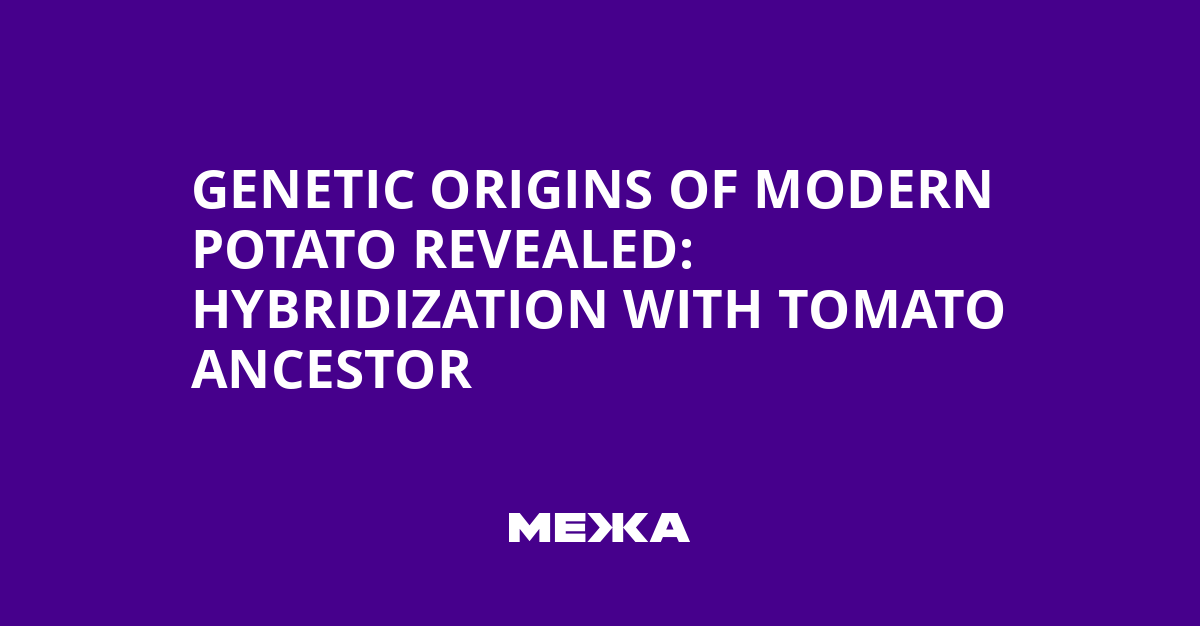The modern potato, first domesticated around 10,000 years ago in the Andes, has become one of the world’s most important agricultural crops. However, because plants rarely preserve well in the fossil record, its origins remained a mystery for a long time.
Recently, a group of evolutionary biologists and genomic scientists traced the roots of this starchy crop back to an accidental encounter with an unexpected relative – the tomato – that occurred millions of years ago.
The researchers analyzed 450 genomes from both cultivated and wild potato species. Genetic analysis revealed that the wild ancestor of the tomato crossed with a potato-like plant known as Etuberosum about 9 million years ago. Both plants descend from a common ancestor that lived around 14 million years ago, according to a study published in the journal Cell.
Although neither tomatoes nor Etuberosum had the ability to form tubers – the edible parts of the plant that grow underground – the hybrid plant acquired this trait. Tubers evolved as an innovative way to store nutrients underground, helping the potato survive in the colder climate of the Andes. Over time, this feature made the potato a vital part of the human diet. Today, there are over 100 wild potato species that also form tubers, although not all are edible due to the presence of toxins.
“The evolution of the tuber gave the potato a huge advantage in harsh conditions, driving an explosion of new species and the rich diversity of potatoes we rely on today,” said the study’s lead author Sanwen Huang, president of the Chinese Academy of Tropical Agricultural Sciences.
The scientists also identified which genes each plant contributed to tuber formation. Understanding the origin and evolution of the potato could help develop more resilient varieties capable of withstanding diseases and climate change.
Potatoes, tomatoes, and Etuberosum all belong to the genus Solanum, which includes about 1,500 species and is the largest genus in the nightshade family. At first glance, the potato closely resembles Etuberosum, which initially led scientists to consider them close relatives, explained co-author Jianquan Liu, professor of ecology at Lanzhou University.
The genus Etuberosum includes only three species. Although these plants have flowers and leaves similar to potatoes, they do not form tubers.
“Etuberosum are special plants that you’re unlikely to see unless you visit the Juan Fernández Islands or the tropical forests of Chile,” said co-author Sandy Napp, a botanist at the Natural History Museum in London.
However, genetic analysis revealed an unexpected result: the potato turned out to be closer to tomatoes than to Etuberosum, depending on the genetic markers used, Liu explained.
The common ancestor of tomatoes and Etuberosum, which lived 14 million years ago, disappeared, so scientists searched for traces of its genes in modern plants.
“We use signals from the past preserved in plants today to reconstruct their history,” added Napp.
To do this, the researchers assembled the most comprehensive database of wild potato genomes to date, including museum specimens and rare species that grow only in isolated Andean valleys.
“Wild potatoes are very difficult to collect, so this database is the most complete collection of wild potato genomic data ever analyzed,” said co-author Zhiyang Zhang.
The study showed that the first potato and all its descendants contained genetic material from both Etuberosum and tomatoes.
Climate changes or geological processes likely contributed to the ancestors of these plants coexisting in the same place, allowing them to crossbreed, Liu explained.
Since both species are pollinated by bees, it is most likely that a bee transferred pollen between the plants, leading to the emergence of the potato, noted Amy Charkowski, a research scientist at Colorado State University.
The SP6A gene, inherited from the tomato, triggered tuber formation, while the IT1 gene from Etuberosum controlled the growth of underground shoots that formed the starchy tubers. The absence of either gene would have made tuber formation impossible, the scientists noted.
“During hybridization, genes shuffle like a deck of cards. Fortunately, in this case, the two necessary genes combined, enabling tuber formation – it was a chance event,” explained Napp.
The evolution of the tuberous potato coincided with the uplift of the Andes, which created diverse ecosystems at high altitudes. Tomatoes prefer dry and warm climates, while Etuberosum favors temperate ones. The potato’s ancestor adapted to the cold and dry conditions of the highlands, where tubers ensured survival, Napp added.
Today, the potato is the world’s third most important food crop after wheat and rice, together providing about 80% of the calories in the human diet.
Understanding the potato’s origin could help breed new varieties with improved traits, including fast-growing potatoes that can be propagated by seed, a focus of Huang’s team.
Modern crops face challenges from climate change, new pests, and diseases. Propagating potatoes by seed could increase genetic diversity and resilience to these threats, unlike vegetative propagation, which produces genetically identical plants vulnerable to disease.
Studying wild species adapted to harsh conditions is also important for breeding, Napp added.
“The methods used in this study will help explore other important plant traits, such as resistance to diseases, pests, drought, and nutritional quality,” said Charkowski.
The potato remains an important crop in arid regions and highlands where other crops do not grow.
These discoveries highlight the potato as the result of a chance meeting between two very different plants, giving its history a romantic touch, said co-author Tina Särkinen.
“The origins of many species are complex and tangled stories, and it’s very exciting that we can now uncover these mysteries thanks to the wealth of genomic data,” she said.

